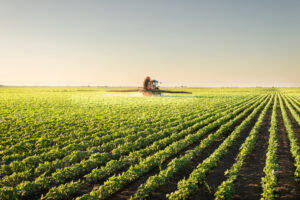
As autonomous tractors are being introduced on the farm today, their deployment underscores how farmers are often at the forefront of adopting new technology.
In a time where our next meal or grocery store delivery is just a tap and a swipe away, we rarely take the time to stop and think about exactly where our food comes from. But we should.
Some distance from your local market or chain store, farmers nurture a variety of crops so they can flourish to support and sustain the community. With the help of sophisticated machines and technology, farmers are hard at work every day to grow the food that ends up on store shelves. But what if these tasks could happen entirely on their own, without human intervention? Imagine the concept of a fully autonomous farm where every aspect, from planting to harvesting, is managed by advanced systems and machines – what may surprise you is that this future is actually much closer to reality than you could imagine.
Considering the stakes at play, increasing the productivity and efficiency of farms through automation and robotics is not just an opportunity but an imperative. According to the UN, the population is expected to reach nearly 10 billion people by 2050 while the availability of local, skilled on farm labor is has steadily declined over the past half century. Each piece of advanced technology deployed on the farm becomes a key piece in feeding our ever-growing population.
The Concept of the Autonomous Farm
The fully autonomous farm is a place where enhanced machines – from automated planters to autonomous tractors – take over many of the arduous tasks of the farming process, freeing up farmers valuable time to focus on the most pressing tasks, increasing their overall productivity, and allowing them to allocate their scarce resources in the most important places.
On today’s farms, the journey towards the fully autonomous farm has already begun. Processes that were once labor-intensive and difficult to complete in the tight windows of time available can be better managed thanks to advanced technology. Today’s enhanced machines are precursors to the fully autonomous farms of the near future where robotics and automation fully encompass the farming process.
Unlike on the roads, where Advanced Driver Assistance Systems (ADAS) have only begun to become prevalent in passenger vehicles over the last few years, automatic steering was introduced into agriculture over 20 years ago and has found widespread adoption. It’s actually rare not to see a tractor or other agriculture machine being manually steered, and this technology has had a profound impact on the precision and repeatability of farming operations, but also on the quality of life for equipment operators.
See also: Automation Helps Farmers Improve Sustainability
The Time Is Now
Automatic steering isn’t the only way automation has made an impact on the farm. These machines don’t just move from point A to B across a field; they are multifunctional, modern-day workhorses that can complete an array of jobs thanks to automation and robotics.
A modern planter is a great example. With robotics and sensors throughout, planters enable farmers to put seeds into the ground at an incredibly fast pace and accurate depth, which is a crucial factor for crop success and health. Plant the seeds too close, and they may fight over resources. Plant the seed too deep, and the farmer risks the crop emerging at the wrong time, throwing the meticulously planned season and timeline into disarray. An advanced planter can place 6,600 seeds into the ground in three seconds. With more than 54 robotic row units working together, the process is akin to a symphony orchestra performing a masterpiece. These automation capabilities exemplify the early parts of the ecosystem of integrated machines, hardware, and software that will be required to realize a fully autonomous farming future.
Automation technology in farming does not just enhance farm productivity and efficiency; it is also improving sustainability. As each of those thousands of seeds are placed in the ground, the automated planter sprays just the necessary amount of fertilizer to help ensure successful plant growth. By leveraging robotics and automation for the precise use of fertilizer, farmers can reduce the amount needed by more than 60%, which is important since that’s where over half of all greenhouse gas emissions on the farm come from.
Planting is only one step of the farming process that’s been impacted by advanced technology. It’s also improving processes for nurturing crops.
With the aid of artificial intelligence and robotics, modern sprayers have made the process of weed management far more efficient and cost effective. Spraying typically involves farmers blanketing their fields with pesticides, which protects against weeds but also hurts the growth of some crops and comes with a high price tag.
Advanced sprayers loaded with GPUs, cameras, and neural networks trained on hundreds of thousands of images of plants differentiate between crops and weeds and apply precise amounts of herbicides only to the weeds. Moving at a speed of up to 15 miles per hour, the cameras on these machines can process images at a rate of every 50 milliseconds. With each pass over the field, they become more and more accurate at identifying and managing weeds while providing detailed data for farmers to make more informed subsequent management decisions. This precise application can help reduce total herbicide use by two-thirds, lowering the high price tag for farmers and improving their bottom line.
In the past few years, we’ve witnessed the next phase in this evolution: the emergence of fully autonomous tractors. These machines work fields from beginning to end without the need for an operator in the cab. Built on top of automatic steering and technology pioneered for on-road driving applications, autonomous tractors are the first generation of technology that can meaningfully close the skilled labor gap present across farms – a fact that has been labeled too hard or too innate to the industry for decades. Starting with tractors and some of the simpler jobs, this is a continued shift towards the fully autonomous farm. Other automated machinery has become commonplace and can carry out tasks with greater precision, speed, and consistency than previously possible. The need for a skilled operator in the cab will be reduced as these machines learn to navigate their environments safely, reliably, and productively on their own.
This is not to say that the role of human capital on the farm will be diminished, but that people’s role on the farm will transition from carrying out these repetitive tasks to overseeing and orchestrating systems of machines that autonomously carry out individual tasks while communicating with other machines and learning from their environment.
See also: Why Data Should Be a Farmer’s Best Friend
The Future Is Autonomous
As automation and robotics have steadily evolved – from the introduction of automatic steering decades ago to sprayers that can manage every individual weed on a farm – the future points toward a fully autonomous farm. The realization of full autonomy will deliver even greater efficiency and precision, as farmers won’t need to be present in the cab anymore. As autonomous tractors are being introduced on the farm today, their deployment underscores how farmers are often at the forefront of adopting new technology and that the story of how your most recent food delivery got from farm to swipe to table might be much more draped in future technology that you first expected.
So why should you care where your food is grown?
Farmers work up to 18 hours a day to feed and clothe our population, and they’ve adopted new technologies to continue their role as stewards of our land. As agriculture enters this new era, technology will be essential to maintaining food security for our growing population.



























